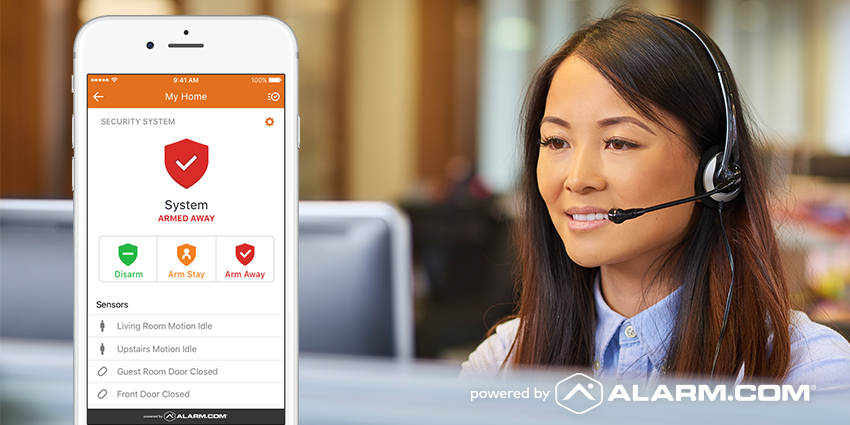As a complete integrator of both residential and commercial security, we have to keep up with evolving technology in our industry. Doing so helps us install the most effective security possible, at the most competitive price point that we can. Over the past several decades, the evolution of wireless security measures has represented one of these improvements. This aspect of security equipment now allows us to install our products more quickly than ever, sometimes in areas that we may not have had access to in the past. In this post, we share several different types of equipment that we can now install wirelessly.
For starters, we’ll share how wire-free security has affected our burglar alarm installation. This will include a look at wireless sensors, which represent “early” wireless alarm technology. Then, we’ll see how this concept has pushed beyond sensors and into the world of wireless keypads, alarm panels, and security system communicators. Finally, we’ll shift our focus to how the wireless trend has affected camera technology and installation. Now, let’s get started by seeing how the wireless security trend works within the world of burglar alarm systems!
Wireless Burglar Alarm Technology
Several decades ago, installing a burglar alarm required running quite a bit of wiring. “Traditional” burglar alarms have wires running from every alarm keypad and security contact back to a main electrical panel at a central location. Of course, installing an alarm this way often proved tedious and time-consuming. For the customer, this led to costly installation prices. Additionally, it often led to frustration when customers experienced lightning strikes or other wiring issues down the road. In fact, the cost to troubleshoot these issues often approaches the cost of installing the alarm in the first place! Luckily, the advent of wireless alarm technology has changed all of this. In this section, we’ll see how this has happend. Let’s start with an overview or wireless security sensors!

Wireless window and door sensors, such as this model by Interlogix, utilize batteries and radio frequency technology to communicate to the alarm’s main panel.
Wireless Security Sensors
As we mentioned, installing hardwired alarm systems requires running wires from the alarm panel to each alarm contact or sensor. These include door and window contacts, glass break and motion detectors, and in some cases monitored smoke and fire detection devices as well. Ideally, home or business owners would call us to run this wiring during a property’s construction. However, sometimes they failed to do so. In some cases, this limited the amount of security we could actually provide. After all, finishing a building often closes some areas up and makes them inaccessible to our technicians. Rooms within finished basements and second-story doors and windows, for example, could not always be fully secured if we could no longer run our wires to them.
Wireless alarm contacts changed all of that. These contacts use a battery, rather than a wire, for power. They communicate back to the security panel using a shared radio frequency. Because of this, some people refer to them as “RF” sensors, short for “Radio Frequency.” These days, just about every type of hardwired security sensor has a wireless counterpart. Furthermore, advances in radio frequency signal strength and transmission range have made these sensors more powerful than ever. Due to this increases wireless coverage, even larger homes and some commercial spaces make good landing places for wireless alarm contacts. Now, let’s see how this early wireless alarm technology has advanced beyond keypads to other areas of alarm-related equipment.
Wireless Keypads and Panels
These days, most alarms have the ability to communicate with wireless sensors. However, a few have the capacity to integrate even more unique time and money-saving devices. For example, even alarm systems that allow you to install wireless sensors traditionally required fully hardwired keypads. This limited where we could install the keypads that security customers use to control their alarms. However, we now offer a variety of wireless secondary keypads that allow us to install keypads just about anywhere on your property without running wiring.
Some of these keypads use a radio frequency to “talk” to the security panel, similar to the way our RF alarm sensors do. Furthermore, modern alarm keypads can utilize your home’s wifi for communication with the alarm panel. This can increase the distance that we can put between the keypad and the alarm’s control unit. Instead of needing to communicate all the way back to the system’s main panel, now the panel and remote keypad only need to be connected to the same wifi network!
Finally, a number of the panels that we install actually have a single keypad/panel “all-in-one” unit. These panels, such as our preferred QOLSYS IQ Panel 4 model, provide incredible ease of installation. Rather than installing a control panel and a hardwired keypad, we can now provide customers with a tablet-sized keypad that has the main control board and alarm siren included right in the keypad itself. This gives you the most technologically-advanced, and often cost-effective, alarm installation available today. Now, let’s turn our attention to a different type of wireless security device that monitors your alarm system without the use of phone lines.
Wire-Free Communicators
If you’ve followed our blog at all, you know that we recommend having your burglar alarm monitored. In the past, our monitored alarm customers required phone lines to make this happen. Tying a phone line into an alarm allows the alarm to call out to our central station upon activation. In turn, our central station would call the premises and, if necessary, dispatch the authorities for help.
Unfortunately, phone line monitoring has severe limitations. For starters, most properties no longer have true hardwired phones on site at all. Rather, they use their cell phones or internet-based phones for communication. Additionally, phone service often proves unreliable in inclement weather. Finally, burglars often cut a property’s phone lines before attempting a break-in. They do so in order to potentially eliminate your alarm’s ability to call for help.

Monitoring your security system through an interactive cellular service such as Alarm.com allows you to both monitor and control your alarm system through a cellular network.
Luckily, we now have devices that create a wire-free solution for alarm monitoring. Our most popular solution to these issues is our Alarm.com cellular dialer. This dialer uses a cellular network to communicate to our central station. Therefore, none of the issues listed above have any affect on your alarm’s monitoring. Furthermore, our Alarm.com customers can also remotely control their security systems using the Alarm.com smartphone app! This allows them to arm and disarm their alarm from anywhere in the world. It also allows them to receive text alerts about alarm status updates and events. The unique combination of security and convenience offered by this product makes it our most effective form of alarm monitoring! Let’s finish up our discussion on wireless security with a section on wire-free surveillance measures.
Wire-Free Cameras
We’ve long touted security cameras as one of the most effective forms of security available. Installing cameras allows you to review any crimes or suspicious happenings on your property. Moreover, cameras also provide a visible deterrent that often encourages criminals to choose another target. Just as with their security contact counterparts, installing cameras traditionally required running wiring from a central location to each camera location. However, recent technology developments have made this issue a thing of the past.
We offer smart cameras that use your property’s wifi signal to transmit video to your phone. These cameras can use cloud-based or SD-card reliant methods to store video footage. They can also use your wifi signal to send video to a recorder, which then saves several weeks’ or even months’ worth of footage onsite. These options let us install cameras for a fraction of the cost that hardwired cameras command. Just as with wireless alarm contacts, this technology also allows us to install surveillance cameras in areas inaccessible for running wire as well!
Putting Wireless Security to Work for You
We hope that this review of wire-free security products helps you find the options that work best for you! Additionally, we also encourage you to contact us with any questions that the material here presents. We will gladly help you understand all of your security options. Furthermore, we also offer free security audits and equipment quotes to both new and existing alarm customers. During our visit, we can address any security concerns you may have. Moreover, we can make suggestions based on our own observations made during our visit. Together, we can create a complete security plan that takes advantage of the latest and greatest in security technology to keep you, your property, and your family as safe and secure as possible!
